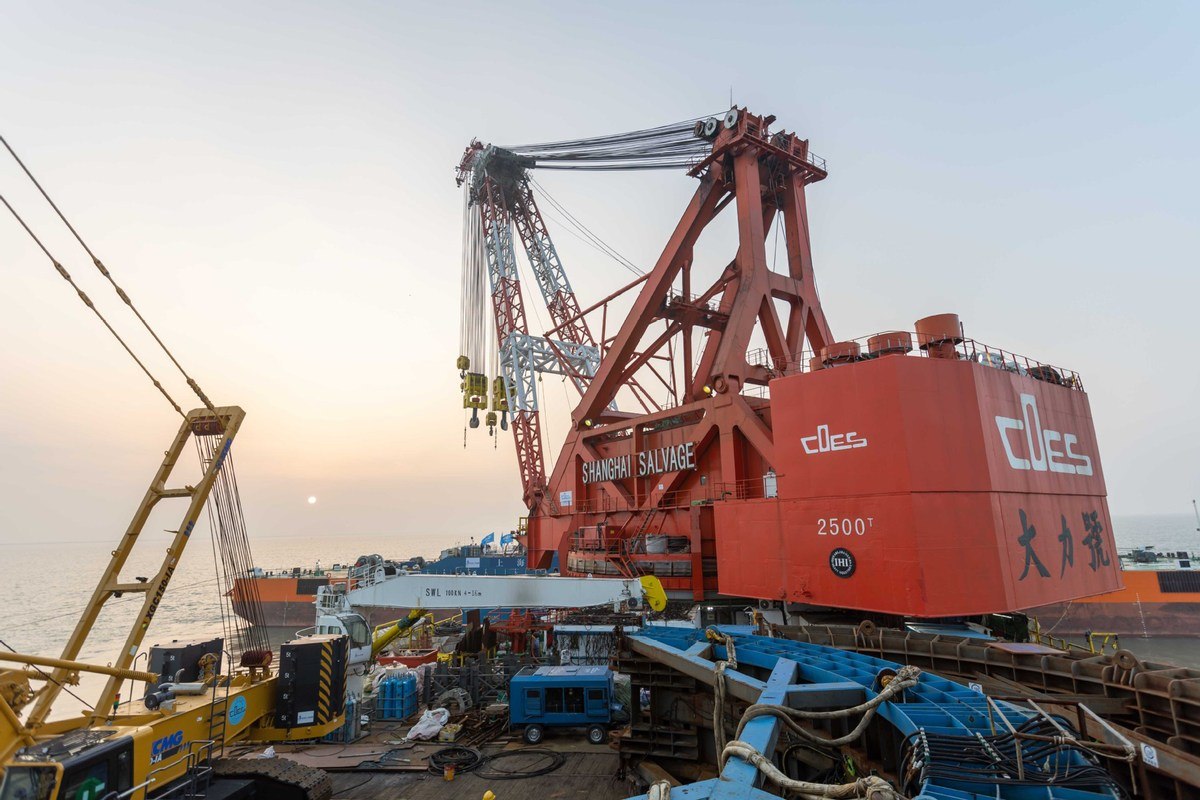
The Yangtze Estuary No 2 Ancient Vessel is salvaged in waters near Shanghai on Monday. The 150-year-old merchant vessel was raised from the riverbed in a high-tech operation that managed to keep the vessel's structure intact, the National Cultural Heritage Administration said. (Photo/Jin Liwang, via Xinhua)
A 150-year-old shipwreck believed to be a treasure trove of cultural relics was successfully lifted from a riverbed near Shanghai early Monday morning in a high-tech salvage operation.
The merchant ship, referred to as Yangtze River Estuary No 2 Ancient Vessel, dates back to the reign of Emperor Tongzhi (1862-1875) in the Qing Dynasty (1644-1911). When it was discovered in 2015 it was sitting 5.5 meters below a shoal off the northeast tip of Hengsha Island in Chongming district.
Recovery of the merchant vessel — about 38.1 meters long and 9.9 meters across at its widest point — was one of the most important and challenging underwater archaeological excavation projects China has undertaken, the National Cultural Heritage Administration said.
During the operation, the Fenli workboat placed 22 giant arc-shaped beams around the vessel to form a semi-cylindrical caisson, or watertight container, 48-meters long, 19-meters wide, 9-meters tall and weighing 8,800 metric tons.
The vessel, along with sediment and seawater, was then lifted into a central open "moon pool" of the salvage vessel, The Global Times reported. The operation began late on Sunday night and was completed by 00:40 am on Monday.
The successful retrieval of the vessel "marks the perfect combination of underwater engineering and cultural relics protection principles," said Guan Qiang, deputy director of the National Cultural Heritage Administration.

This photo taken on Nov 20, 2022 shows a view of the salvage operation of the Yangtze Estuary No 2 Ancient Vessel in Shanghai, East China. An ancient shipwreck, one of the largest and best-preserved wooden shipwrecks discovered underwater in China to date, was lifted out of waters in Shanghai early Monday. (Photo/Xinhua)
"The project has provided a Chinese example, Chinese model, and Chinese experience for the global protection of underwater cultural relics," he said.
In the coming days, another vessel will take the shipwreck to the former site of Shanghai Shipyard in Yangpu district where it will be examined and studied. The ship has been described by the heritage administration as "the largest and best-preserved sunken wooden sailboat in China's underwater archaeological findings, with a huge number of cultural relics on board".
Fang Shizhong, director of the Shanghai Cultural Heritage Administration, said that the discovery of the ancient boat "proves Shanghai's position as an important shipping and maritime commerce center for East Asia and even the whole world."
In 2015, an underwater archaeological investigation in the Hengsha area detected a sunken iron vessel via sonar scanning technology, local media reported.
The iron warship was named the Yangtze River Estuary No 1 Ancient Vessel. As archaeologists expanded the scope of their scan, a wooden vessel was found north of the warship and named the Yangtze River Estuary No 2 Ancient Vessel.
A total of 31 cargo chambers were detected in the No 2 vessel, with its main structure almost intact, including the prow, bollard, port side and starboard.
Items have already been retrieved from four selected chambers, including ceramic objects made in Jingdezhen, Jiangxi province. Also found on the vessel or scattered nearby it were purple clay objects, pots made in Vietnam, pulleys, cables and construction material.
Chu Xiaobo, director of Shanghai Museum, said in a CCTV livestream that the shipwreck contains so much historical information that it is equivalent to the long scroll painting Along the River during Qingming Festival, a revered painting that depicts daily life during the 11th and 12th centuries in China.
Author: Zhang Kun
Editor: Tan Qikuan, Yu Fei(Intern)